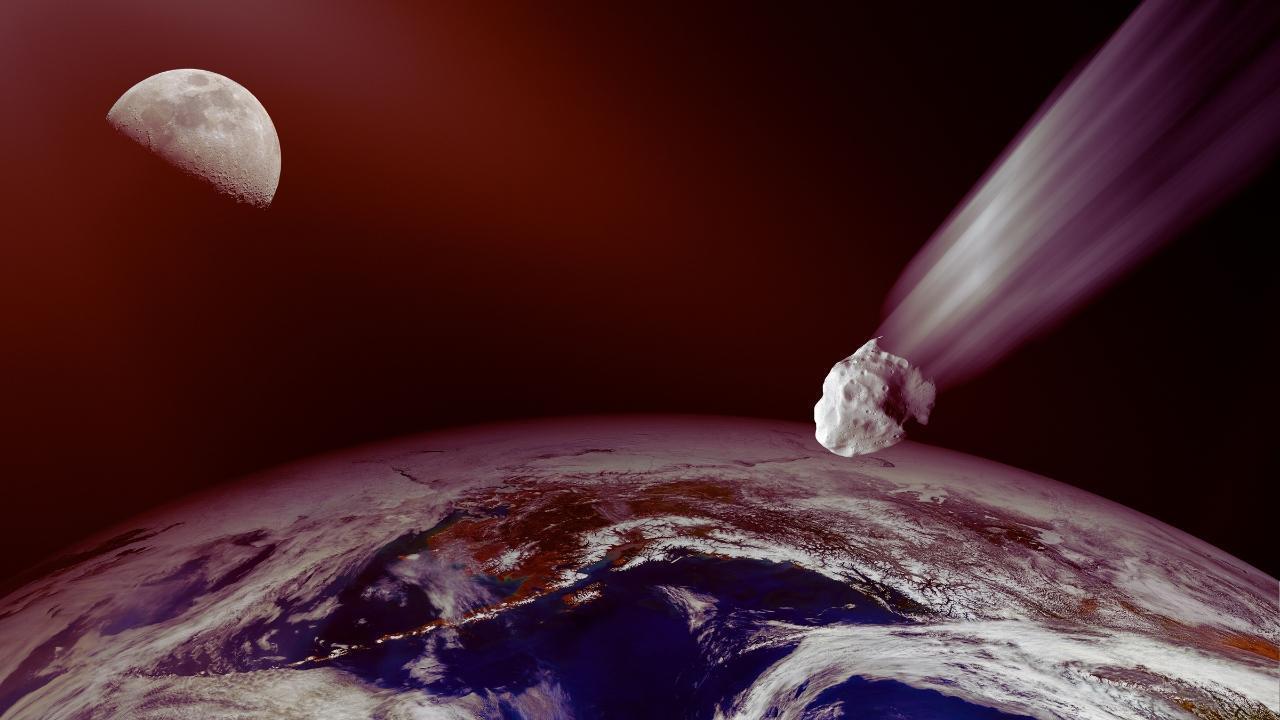
Join 10k+ people to get notified about new posts, news and tips.
Do not worry we don't spam!

Post by : Anis Farhan
On August 5, 2025, NASA confirmed the flyby of a near-Earth asteroid (NEA) designated 2025 OT7—a rocky object roughly the size of a football stadium. Although the asteroid did not pose a collision risk, it came close enough to trigger NASA’s planetary defense protocols and draw attention from astronomers around the world.
OT7 passed at a distance of approximately 2.1 million kilometers from Earth—about 5.5 times the distance between Earth and the Moon. While that might sound far, in cosmic terms, it’s considered a relatively close shave. For scientists, the encounter was an opportunity to test global response mechanisms, improve near-Earth tracking capabilities, and continue assessing the potential threat of larger, untracked objects in the future.
Asteroid OT7 is estimated to be about 190 meters in diameter. To put that in perspective, it’s nearly double the size of the asteroid that exploded over Chelyabinsk, Russia in 2013. That asteroid, though only about 20 meters wide, injured over 1,500 people and damaged thousands of buildings due to the shockwave it generated.
An object the size of OT7 has the potential to cause regional devastation if it were to ever collide with Earth. NASA’s classification of such objects falls under the “Potentially Hazardous Asteroid” (PHA) category—reserved for any asteroid that comes within 7.5 million kilometers of Earth and is larger than 140 meters.
Though OT7 was never on a direct collision course, its size and trajectory made it a high-interest subject for planetary scientists.
Another crucial factor that makes OT7 noteworthy is its speed. The asteroid was traveling at approximately 37,000 kilometers per hour relative to Earth. At such velocities, even a relatively small object can release energy equivalent to dozens of nuclear bombs upon impact.
NASA and other international space agencies used a suite of radar and optical tracking systems to measure the asteroid’s path and speed. Continuous tracking over several days confirmed that there was no deviation in its projected trajectory, ruling out any impact threat with Earth for the foreseeable future.
Near-Earth Objects (NEOs) are asteroids or comets whose orbits bring them close to Earth. While many are small and burn up in our atmosphere, larger ones—especially those above 140 meters—can be catastrophic if they strike land or sea.
NASA and space agencies like ESA (European Space Agency), JAXA (Japan), and ISRO (India) have systems in place to monitor and catalog these objects. NASA’s Center for Near Earth Object Studies (CNEOS) maintains a database of thousands of such objects, tracking their movement and probability of impact using advanced computational models.
The flyby of OT7 offered another data point in this growing repository and gave experts real-time experience in monitoring high-speed cosmic objects.
NASA was not alone in observing OT7. Observatories across Europe, Asia, and South America participated in coordinated efforts to track and analyze the asteroid. Ground-based radar systems, like those at the Goldstone Deep Space Communications Complex in California, played a pivotal role in capturing high-resolution images of the asteroid’s shape and spin.
In addition, amateur astronomers also joined the effort. Using high-powered telescopes, several enthusiasts were able to record OT7’s movement across the sky as it zipped past Earth. Social media was abuzz with amateur footage and updates from astronomy communities, reflecting growing public interest in planetary defense.
Though OT7 was widely reported, it’s not the only asteroid to pass near Earth in recent times. In fact, flybys occur frequently—sometimes several times a month. Most, however, involve smaller objects that pose minimal risk.
What made OT7 significant was its combination of size, speed, and relative proximity. In 2023, asteroid 2023 DZ2 passed closer than the Moon, and in 2004, asteroid Apophis drew global concern before being ruled out as a threat. Compared to those, OT7 was notable but not alarming.
Still, each encounter is a reminder of Earth’s vulnerability and the importance of preparedness.
NASA’s Planetary Defense Coordination Office (PDCO) was established precisely to handle such scenarios. Following the flyby, officials stressed that while OT7 posed no threat, it served as a live rehearsal for future preparedness.
In 2022, NASA successfully tested the DART (Double Asteroid Redirection Test) mission by crashing a spacecraft into an asteroid to slightly alter its trajectory. That success proved it is possible to change an asteroid’s path using kinetic impact. Scientists hope that with more advanced missions, we’ll be ready if a real threat ever emerges.
The flyby of OT7 allowed the PDCO and its international counterparts to review procedures, identify areas for improvement, and validate their response systems. These learnings are invaluable in building a coordinated global response to future threats.
The honest answer is: it’s unlikely, but not impossible.
Large-scale asteroid impacts are extremely rare. According to NASA estimates, an asteroid larger than 1 kilometer hits Earth once every 500,000 years on average. However, smaller but still dangerous objects—like OT7—may strike more frequently, roughly every 10,000 to 20,000 years.
The Chelyabinsk event in 2013 was a wake-up call. No one saw that asteroid coming. It entered Earth’s atmosphere without warning and caused considerable damage. Since then, international efforts to detect and track such objects have ramped up significantly.
Still, Earth’s skies remain only partially monitored. While major space agencies are constantly scanning the heavens, thousands of asteroids likely remain undetected—especially those that approach from the direction of the sun, which makes them difficult to spot with traditional telescopes.
In the wake of events like OT7’s flyby, new missions are being developed to increase our planetary awareness. NASA is working on the NEO Surveyor mission—a space-based infrared telescope specifically designed to detect potentially hazardous asteroids.
ESA, meanwhile, is preparing for its Hera mission to analyze the aftermath of the DART impact on asteroid Dimorphos. The aim is to develop a deeper understanding of how kinetic impact strategies work and what modifications might be needed for different types of asteroids.
There’s also increasing collaboration between private space companies and national agencies. Commercial satellites are beginning to be used in tandem with government observatories to track fast-moving NEOs with greater precision.
Beyond space agencies, public understanding of asteroid threats is vital. Events like OT7's flyby help boost global awareness and remind people of the importance of science, observation, and international cooperation.
Schools, museums, and science centers took advantage of the event to educate students about space, gravity, and Earth’s relationship with the cosmos. Social media campaigns shared visualizations and 3D models of the asteroid, helping to make the science accessible and engaging.
Asteroid 2025 OT7 passed Earth without incident—but not without significance. It served as a powerful reminder that Earth travels through a busy, dynamic solar system where surprises are still very much possible.
As detection technologies evolve and global coordination strengthens, humanity is better prepared than ever to defend against the unlikely but catastrophic possibility of a future impact. For now, OT7 becomes part of our growing archive of near-miss events that teach us how to watch, learn, and stay ready.
This article is intended for informational and editorial purposes only. The scientific data and astronomical observations referenced are based on publicly available information from recognized space agencies and research institutions as of the time of writing. Readers are advised to consult official NASA and international space agency sources for real-time updates and technical details regarding asteroid activity and planetary defense initiatives.










Paramount+ to Stream PBR’s 'Unleash the Beast' in New Five-Year Deal
Paramount+ will stream PBR’s 'Unleash the Beast' across the U.S. starting this December under a five

Zohran Mamdani Clinches NYC Mayoral Seat as Victory Speech Blends Politics and Bollywood
Zohran Mamdani won New York City's mayoral race, becoming the city's first Muslim and South Asian ma

India Wins First Women’s World Cup 2025 Title
India lifts its maiden Women’s World Cup 2025 title! Harmanpreet Kaur’s team stuns South Africa in a

Manuel Frederick, 1972 Olympic Bronze Goalkeeper, Dies at 78
Manuel Frederick, a member of India’s 1972 Olympic bronze hockey team, has died in Bengaluru at 78 a

Muhammad Hamza Raja Wins IFBB Pro Card Puts Pakistan & UAE on Global Stage
Pakistani bodybuilder Muhammad Hamza Raja earns IFBB Pro Card in Czech Republic, showcasing Dubai’s

Shreyas Iyer’s Recovery Underway After Spleen Laceration in Sydney ODI
Shreyas Iyer is recovering after a spleen laceration sustained while taking a catch in the Sydney OD